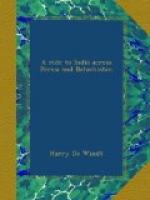About midday we came to a broad but fordable river, which the Khivan called the Chulamak. We all crossed in safety, notwithstanding the deep holes our guide warned us against, and which, as the water was thick and muddy, gave Gerome and myself some anxiety. The stream was about fifty yards across and much swollen by the snow. Landing on the other side ahead of my companions, I rode on alone, and presently found myself floundering about girth-deep in a quicksand. It was only with great difficulty that we extricated the pony. These quicksands are common on the shores of the Caspian, and natives, when travelling alone, have perished from this cause.
Nothing occurred worthy of notice till about 3 p.m., when we reached the river Djemnil. An arm of the sea more accurately describes this stream, which is (or was at the time of which I write) over three hundred yards across. Here we had some difficulty with the Khivan, who was for encamping till morning. I, however, strongly objected to sleeping a la belle etoile, especially as the sky had now clouded over, and it was beginning to snow. Partly by conciliation, partly by threats, we at last persuaded him to make the attempt, following closely in his wake. It was nasty work. Twice our horses were carried off their feet by the strong current running out to sea (we were only a quarter of a mile from the mouth); and once we, or rather the horses, had to swim for it; but we reached the opposite shore in under half an hour, wet and numbed to the waist, but safe. At seven we were snugly housed for the night at Katvesera, a so-called village of three or four mud hovels, selecting the best (outwardly) for our night’s lodging. We were badly received by the natives. Neither money nor threats would induce them to produce provisions of any kind, so we fell back on sticks of chocolate and Valentine’s meat-juice. The latter I never travel without—it is invaluable in uncivilized and desert countries.
The inhabitants of Katvesera are under a score in number, and live chiefly on fish, though I noticed in the morning that a considerable quantity of land was under cultivation—apparently rice and barley. They were a sullen, sulky lot, and we had almost to take the hut by force. The Khivan, Gerome, and myself took it in turns to watch through the night. It was near here that the Italian was assassinated.
A start was made at daybreak. The weather had now changed. A cutting north-easter was blowing, accompanied with snow and sleet. We forded, about 11 a.m., the Kokajeri river, a mountain stream about thirty yards wide, unfordable except upon the sea-beach. At midday we halted at Tchergari, a fishing-village on the shores of the Caspian.




